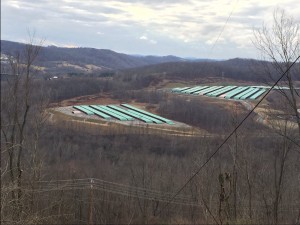Report to Monongalia County Commission By Wallace Venable, September 21, 2020
Early this month Dr. Duane Nichols appeared at a Commission meeting to tell you about potential dangers from the degradation of the epoxy coating on the pipe stored outdoors at Morgantown Industrial Park. As he noted, the coating contains numerous carcinogenic and toxic substances that could leach or blow off stored pipes. These substances could result in negative impacts to the health and safety of residents or workers in proximity to the locations where the pipes are stored.
This brief report adds quantitative estimates to his information.
Quantities of Pipe in Storage
Ariel photos accessible through Google Maps allow some appraisal of the extent of the pipe storage at Morgantown Industrial Park. There are two pipe storage areas. Based on shadows, most, if not all, of the stacks are four pipes high.
Not all pipes are the same length, but the majority appear to be 40 feet long. The pipeline has been described as using 42 inch diameter pipe.
In the upper storage area there are approximately 5,680 lineal feet of pipe stacks, which with a 40 foot pipe length, gives approximately 227,200 square feet of pipe in the top layer. Roughly, this area contains about 6,500 pieces of pipe.
In the lower storage area there are approximately 2,690 lineal feet of pipe stacks, which with a 40 foot pipe length gives approximately 107,600 square feet of pipe in the top layer. Roughly, this area contains about 3,075 pieces of pipe.
That gives a total of about 9,600 pieces of pipe, covering an actual ground space of about 334,600 square feet. The surface area of the pipe itself exposed to the atmosphere is approximately four million square feet.
Degradation of Epoxy Coating Four Years in Storage
There is some information publicly available from 3M on typical rates of the coating’s degradation. Their estimates range from 0.375 to 1.5 thousandths of an inch per year. The degradation happens faster in higher temperatures, higher humidity, and wetter conditions. Presumably this is after underground installation. Degradation is accelerated by exposure to the sun. The top layer is directly exposed to the sun, and will have the highest degradation rate due to ultraviolet light exposure.
Quantity Estimates of Degradation Products
I have made two estimates of the amount of degradation products with which the Morgantown area will have to deal. The first is based on the area exposed directly to sun and rain, the second based on the total area of the pipe exposed to the atmosphere.
Using the area exposed directly to sun and rain and a rate of degradation of 0.0015 inches per year, we can expect to generate on the order of 42 cubic feet, or two tons, of chemical sludge per year.
Using the total area of the pipe exposed to the atmosphere and the lower rate of degradation of 0.000375 inches per year, we can expect to generate on the order of 120 cubic feet, or six tons, of chemical sludge per year.
While we cannot make a precise estimate of the total pollution being generated, a reasonable estimate is that the site is currently creating a few tons of particles per year.
Given that pipe has been stored on the site for several years, we can expect that as much as twenty tons has already been released. Even immediate removal of the pipe itself will not remove this material.
Dispersal and Disposal of Degradation Products
As Dr. Nichols told you, the primary danger to people is probably through air-borne dust breathed by employees at the Morgantown Industrial Park. Construction of the new I-79 Interchange will both increase the number of affected workers and increase dust distribution through increased traffic.
Degradation products not carried away by wind will be carried primarily to the three settlement ponds on site. There will also be other ground run-off mixing with the chemical sludge.
We have no evidence that these have been unable to contain past run-off, but they will eventually fill. Because they will be laced with chemical sludge, a plan for their eventual disposal will be needed.
Recommendation to Local County Government
The Monongalia County Commission should establish a plan to assure that the pollution from this storage area is professionally monitored.
>>>>>>>>>>>>>>>>>>>>>>>>>>>>>>
Dr. Wallace Venable is Emeritus Associate Professor of Mechanical & Aerospace Engineering at WVU and Chief Technical Officer of the Upper Monongahela River Association.
#########################
See also: “Toxic Residues from Atlantic Coast Pipe Coatings Pose Public Health Risks in WV, Va & NC,” FrackCheckWV, September 1, 2020
……………………………………………………………………
See also: ”Scotchkote Epoxy Resin Coating for ACP & MVP Results in Toxic Chemicals”, FrackCheckWV, September 2, 2020


{ 1 comment… read it below or add one }
NRC Report: Natural Gas near Westover, WV
Description: Incident Type: PIPELINE – NRC Report ID: 1288263 – Medium Affected: AIR – Suspected Responsible Party: DOMINION ENERGY WV
Incident Date/Time: 2020-09-24 09:00:00
Tags: NRC, other, release
NRC Report: Natural Gas near Westover, WV
Description: Incident Type: PIPELINE – NRC Report ID: 1288188 – Medium Affected: AIR – Suspected Responsible Party: DOMINION ENERGY WV
Incident Date/Time: 2020-09-24 09:00:00
Tags: NRC, other, release
NRC Report: Ethylene Glycol near Pittsburgh, PA
Description: Incident Type: FIXED – NRC Report ID: 1288404 – Medium Affected: WATER – Suspected Responsible Party:
Incident Date/Time: 2020-09-27 13:45:00
Tags: NRC, other, release
SkyTruth
P.O. Box 3283
Shepherdstown, WV 25443
info@skytruth.org
+1 (304) 885-4581